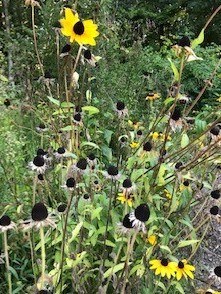Posted: January 10, 2022
Have you thought about saving seeds from your garden?

Photo by Lynn Steele
As the snow is now covering our area, I wanted to see if anyone ever thought about saving seeds from your garden?
The rain gardens at the Middle Smithfield Township (MST) Community and Cultural Center are part of the site plan and now designated as Penn State Extension Demonstration Gardens. One flower that grows there is the Black-eyed Susan (Rudbeckia hirta). This is a photo of what the flowers look like when they are ready for seed saving.
Last Fall, at the MST Community and Cultural Center, The Monroe Master Gardeners participated in an event and gave away Black-eyed Susan (Rudbeckia hirta) seeds from the MST rain gardens.
We would like to share with you how to collect seeds, that can be used the following planting season. This is one way to take your passion for gardening to the next level!
Part of the fun of collecting seeds is growing your own low-cost plants and having extras to share with friends. Just remember that not all plants grown from seed will look exactly like the plants they are gathered from (their parent plants).
For flowering plants that do not make fruit, wait until the flowers have dried up, leaving you with a dry brown seed head. You can snip off a whole seed head into the container of your choosing. Figuring out exactly when your seeds are ready to be harvested may take some practice. Once picked, seeds will not continue to develop, so they do need to be harvested once mature and not too early.
Seed heads and seed pods need to be air-dried after they are harvested. You can lay them out on newspaper or in a shallow box to do this. Make sure you spread them out to allow them room to dry as you want to avoid seeds becoming moldy. Once they have dried out you can shake seeds loose from pods or seed heads. Keep seeds from different flowers in separate paper envelopes and label them with the plant's name and the date collected. It is best to use paper envelopes to store your seeds; if there is even the slightest bit of moisture present, mold can develop. Keep the seeds stored in a cool dry place until it is time to plant.
When you are told to store seeds in a 'cool, dry place,' you may wonder what exactly that means. We recommend putting seed envelopes in a tightly sealed jar in the refrigerator. Some people choose to store seeds in the freezer but this can be tricky as seeds have to be very dry before freezing or the seeds can be killed.
For more information, See Penn State Extension's article on Seed Saving Basics

